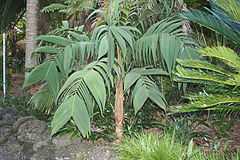Geonoma
| Geonoma | |
|---|---|
 | |
| Young Red Crownshaft Palm (G. undata) | |
| Scientific classification | |
| Kingdom: | Plantae |
| (unranked): | Angiosperms |
| (unranked): | Monocots |
| (unranked): | Commelinids |
| Order: | Arecales |
| Family: | Arecaceae |
| Subfamily: | Arecoideae |
| Tribe: | Geonomeae |
| Genus: | Geonoma Willd. |
| Species | |
|
64, see text | |
| Synonyms | |
|
Gynestum Poit. | |
Geonoma is a genus of small to medium-sized palms native to the forest understorey of tropical Central and South America.
This palm genus is one of the largest in the Neotropics.[1] Its 64 species are distributed from Mexico and Haiti in the north to Paraguay in the south; two are found in the insular Caribbean.[2]
The genus is a member of the palm tribe Geonomeae (Arecaceae: Arecoideae), an important Neotropical group due to its wide distribution across Central and South America, its diversity and abundance, and the use of a number of species by local human populations.[3] The distribution of the tribe Geonomeae stretches from southeast Mexico down through Central America and into South America, notably Brazil and Bolivia, and species are also found in the Greater and Lesser Antilles.[4] This tribe consists of a group of understory and sub-canopy palms that populate both tropical lowland and montane forests. While members of this group are relatively easy to collect, as they are not canopy palms or spiny palms, and are well represented in herbaria, the taxonomy and phylogeny of the species within the tribe are still uncertain.[5][6] The resolution of the tribe has been disputed despite the fact that Geonomeae species are characterized by three morphological synapomorphies: the petals of pistillate flowers are basally connate, the presence of slender and elongate styles, and the flowers are borne in pits in the rachillae.[7]
Species[8]
|
|
Species formerly placed in this genus include Calyptronoma occidentalis (= Geonoma swartzii) and Calyptronoma plumeriana (= Geonoma dulcis, G. intermedia, G. plumeriana).
Footnotes
- ↑ Henderson et al. (1995)
- ↑ Morici (2004)
- ↑ Roncal, J. Francisco-Ortega, C.B. Asmussen, and C.E. Lewis (2005). 'Molecular phylogenetics of the tribe Geonomeae (Arecaceae) using nuclear DNA sequences of Phosphoribulokinase and RNA Polymerase II'. (Systematic Botany 30(2): 275–283).
- ↑ Wessels Boer (1968) as cited by Roncal, J. Francisco-Ortega, C.B. Asmussen, and C.E. Lewis (2005). 'Molecular phylogenetics of the tribe Geonomeae (Arecaceae) using nuclear DNA sequences of Phosphoribulokinase and RNA Polymerase II'. (Systematic Botany 30(2): 275–283)
- ↑ Roncal, J. Francisco-Ortega, C.B. Asmussen, and C.E. Lewis (2005). 'Molecular phylogenetics of the tribe Geonomeae (Arecaceae) using nuclear DNA sequences of Phosphoribulokinase and RNA Polymerase II'. (Systematic Botany 30(2): 275–283)
- ↑ Asmussen, C.B. and Chase, M.W. (2001) 'Coding and noncoding plastid DNA in palm systematics' (American Journal of Botany 88: 1103–1117)
- ↑ Uhl and Dransfield 1987 as cited by Roncal, J. Francisco-Ortega, C.B. Asmussen, and C.E. Lewis (2005). 'Molecular phylogenetics of the tribe Geonomeae (Arecaceae) using nuclear DNA sequences of Phosphoribulokinase and RNA Polymerase II'. (Systematic Botany 30(2): 275–283)
- ↑ Govaerts et al. (2008)
References
| Wikimedia Commons has media related to Geonoma. |
- Govaerts, R.; Dransfield, J.; Zona, S.F; Hodel, D.R. & Henderson, Andrew (2008): search for Geonoma. In: World Checklist of Arecaceae. Retrieved 2008-APR-01.
- Henderson, Andrew; Galeano, Gloria & Bernal, Rodrigo (1995): Field Guide to the Palms of the Americas. Princeton University Press, Princeton, New Jersey. ISBN 0-691-08537-4 HTML preview at Google Books
- Morici, Carlo (2004): Palmeras e Islas: La Insularidad en una de las Familias más Diversas del Reino Vegetal. In: Fernández-Palacios, J.M. & Morici, C.: Ecología Insular/Island Ecology: 81–122. Asociatión Española de Ecología Terestre (AEET)-Cabildo Insular de La Palma [in Spanish]. PDF fulltext
- Roncal, J. Francisco-Ortega, C.B. Asmussen, and C.E. Lewis (2005). 'Molecular phylogenetics of the tribe Geonomeae (Arecaceae) using nuclear DNA sequences of Phosphoribulokinase and RNA Polymerase II'. Systematic Botany 30(2): 275–283.
- Asmussen, C.B. and Chase, M.W. (2001) 'Coding and noncoding plastid DNA in palm systematics' (American Journal of Botany 88: 1103–1117.